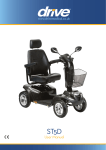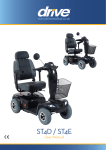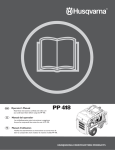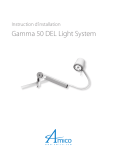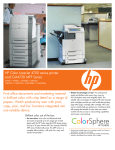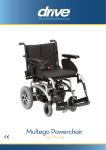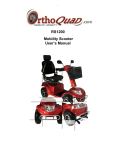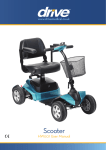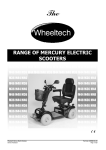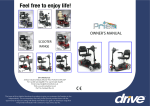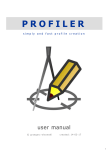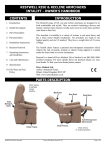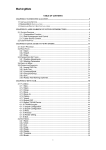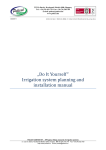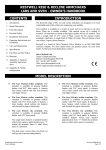Download User Manual
Transcript
www.drivemedical.co.uk ST6 User Manual ST-6 Instruction Booklet TABLE OF CONTENTS INTRODUCTION --------------------------------------------------------1 IMPORTANT PRECAUTIONS ----------------------------------------2 ELECTROMAGNETIC INTERFERENCE AND WARNINGS ----3 IDENTIFICATION OF PARTS ----------------------------------------5 CHARGING THE BATTERIES --------------------------------------11 DISASSEMBLING YOUR SCOOTER ------------------------------13 LCD DISPLAY PANEL ------------------------------------------------15 CAUTION ---------------------------------------------------------------22 TECHNICAL SPECIFICATIONS ------------------------------------23 INSPECTION CHECKS ----------------------------------------------24 ISSUE 1 ST-6 Instruction Booklet INTRODUCTION Thank you and congratulation on purchasing your new Drive Medical Ltd. Mobility Scooter. It is designed to provide you with transportation ability indoors and outdoors. We pride ourselves on providing safe and comfortable products. Our goal is to ensure your complete satisfaction. We sincerely hope you enjoy your new Mobility Scooter. Please read and observe all warning and instruction provided in owner's manual before you operate with various convenient function of this scooter. Also, please retain this booklet for future reference. If you have any question, you can contact : or your local dealer: Information of European Representative : EMERGO EUROPE Molenstraat 15 2513 BH, The Hague The Netherlands 1 ISSUE 1 ST-6 Instruction Booklet IMPORTANT PRECAUTIONS •This scooter is designed for single person use only at any one time. •Maximum User Weight is 226 kg / 498 Ibs •Turn key off before getting on or off. •Always drive carefully and be aware of others using the same area. •Always use pedestrian crossings wherever possible. Take extreme care when crossing roads. •Do not drive on slope exceeding 9 degree, and take extreme care when turning on slope. •Do not use full power when turning to sharp corner. •Take great care and drive in low speed when backing up, riding downhill or on uneven surface, and climbing curb. •Please use the lowest speed when driving through the descending road or uneven terrain. If speed is too fast, leave your hand off the handle bar, let the scooter stop. Make sure safety and start again. •The weight capacity limit at different ramp degree (please refer to following picture). 85 kg / 9 degree 190 kg / 6 degree 226 kg / 3 degree •The grade climbing degree will be affected by weight capacity, driving speed, and ramp degree, and scooter parameter. •To prevent any danger from motor defected; please avoid to drive on long ramp or any uneven terrain. •A slow speed must always be used when ascending, descending or traversing aslope or incline and also on uneven terrain, ramps and soft or loose surfaces, such as gravel or grass. •To prevent any danger, do not turn around at high speed on ascending, descending ramp. •Scooter may not operate well in high humidity. •Do not leave the powered scooter in a rain storm of any kind. •Do not use the powered scooter in a shower. •Direct exposure to rain or dampness will cause the scooter to malfunction electrically and mechanically; may cause the powered scooter to prematurely rust. •Never put scooter in neutral when staying on slopes. •Follow traffic laws when riding outside. •When scooter on moving transport vehicles, do not sit or stay on scooter. 2 ISSUE 1 ST-6 Instruction Booklet ELECTROMAGNETIC INTERFERENCE AND WARNINGS CAUTION: It is very important that you read this information regarding the possible effects of Electromagnetic Interference on your motorized scooter. Powered wheelchairs and motorized scooters may be susceptible to electromagnetic interference (EMI), which is interfering electromagnetic energy (EM) emitted from sources such a radio stations, TV stations, amateur radio (HAM) transmitters, two-way radios, and cellular phones. The interference (from radio wave sources) can cause the motorized scooter to release its brakes, move by itself, or move in unintended directions. It can also permanently damage the motorized scooter control system. The intensity of the interfering EM energy can be measured in volts per meter (V/m). Each motorized scooter can resist EMI up to a certain intensity. This is called its "immunity level." The higher the immunity level, the greater the protection. At this time, current technology is capable of achieving at least a 20 V/m immunity level, which would provide useful protection from the more common sources of radiated EMI. The immunity level of this motorized scooter model is not known. There are a number of sources of relatively intense electromagnetic fields in the everyday environment. Some of these sources are obvious and easy to avoid. Others are not apparent and exposure is unavoidable. However, we believe that by following the warnings listed below, your risk to EMI will be minimized. The sources of radiated EMI can be broadly classified into three types : 1.Hand-held portable transceivers (transmitters-receivers) with the antenna mounted directly on the transmitting unit. Examples include: citizens band (CB) radios, "walkie talkie," security, fire, and police transceivers, cellular telephones, and other personal communication devices Some cellular telephones and similar devices transmit signals while they are ON, even when not being used 2.Medium-range mobile transceivers, such as those used in police cars, fire trucks, ambulances, and taxis. These usually have the antenna mounted on the outside of the vehicle; and 3.Long-range transmitters and transceivers such as commercial broadcast transmitters (radio and TV broadcast antenna towers) and amateur (HAM) radios Other types of hand-held devices, such as cordless phones, laptop computers, AM/FM radios, TV sets, CD players, and cassette players, and small appliances, such as electric shavers and hair dryers, so far as. we know, are not likely to cause EMI problems to your motorized scooter. 3 ISSUE 1 ST-6 Instruction Booklet Motorized Scooter Electromagnetic Interference: Because EM energy rapidly becomes more intense as one moves closer to the transmitting antenna (source), the EM fields from hand-held radio wave sources (transceivers) are of special concern. It is possible to unintentionally bring high levels of EM energy very close to the motorized scooter control system while using these devices. This can affect motorized scooter movement and braking. Therefore, the warnings listed below are recommended to prevent possible interference with the control system of the motorized scooter. Warnings: Electromagnetic interference (EMI) from sources such as radio and TV stations, amateur radio (HAM) transmitters, two-way radios, and cellular phones can affect motorized scooters. Following the warnings listed below should reduce the chance of unintended brake release or motorized scooter movement which could result in serious injury. 1.Do not operate hand-held transceivers (transmitters-receivers), such as citizens band (CB) radios, or turn ON personal communication devices, such as cellular phones, while the motorized scooter is turned ON; 2.Be aware of nearby transmitters, such as radio or TV stations, and try to avoid coming close to them; 3.If unintended movement or brake release occurs, turn the motorized scooter OFF as soon as it is safe; 4.Be aware that adding accessories or components, or modifying the motorized scooter, may make it more susceptible to EMI; and There is no easy way to evaluate their effect on the overall immunity of the motorized scooter. 5.Report all incidents of unintended movement or brake release to the distributor listed on the inside front cover of this manual. Note whether there is a source of EMI nearby. Important Information: 1.20 volts per meter (V/m) is a generally achievable and useful immunity level against EMI (as of May 1994). The higher the level, the greater the protection. 2.The immunity level of this product is at least 20/Vm. 4 ISSUE 1 ST-6 Instruction Booklet IDENTIFICATION OF PARTS Before you take your first trip, you should familiarize yourself well with the operation of the scooter and with all operating elements. Take your time to test all functions and driving modes. Wigwag 22" Captain Seat Hand Brake Tiller Angle Adjustment Angle Armrest Adjustment Seat fore-aft Adj Lever Seat Back Angle Adjustment Headlight Tiller Storage Compartment Turn Signal Rear Bumper Front Bumper Swivel Lever Side Reflector Figure 1 - ST-6 Front View Left Turn Indicator Headlight Indicator Power Indicator High Speed Indicator Right Turn Indicator Hazard Light Rear Mirror Acceleration Rear Bag N-D Lever Turn Signal Horn Left Turn Signal Headlight Right Turn Signal Rear Reflector Deceleration Hi/Lo Switch Anti-Tipper Figure 3 - ST-6 Rear View Figure 2 - ST-6 Control Panel 5 ISSUE 1 ST-6 Instruction Booklet FUNCTION OF PARTS: Main Key Switch (A) 1.Turn the key to the right - Turn the scooter on 2.Turn the key to the left - Turn the scooter off Always ensure that the scooter is switched off before getting on or off the scooter and before removing any items of the scooter (A) Turning the scooter OFF whilst driving will bring the scooter to an abrupt stop and danger. Figure 4 TOP CONTROL PANEL Hazard Light (B) : Switch on by pressing once, switch off by pressing again. Press hazard light button once, the right/left lights and parking indicator start to flash, warning tone acts as well; If the Hazard lights are activated, with the key switched to the on position, the lights will continue to flash even when the key is switched off. The (I) (J) (D) (E) (F) (G) Hazard light button should be depressed to cancel the flashing. (H) (B) Figure 5 Horn (D) : Press horn button once to sound warning tone when necessary. Left Turn Signal (E) : Press Left Turn Signal button once, the front and rear left turn indicators start to flash, and warning tone sounds simultaneously; press button again to switch off the turn indicators/signal and tone. Right Turn Signal (G) : Press Right Turn Signal button once, the front and rear right turn indicators start to flash, and warning tone sounds simultaneously; press button again to switch off the turn indicators/signal and tone Headlight (F) : Press headlight button once to switch on, switch off by pressing again. Acceleration (H) : Press acceleration button once to increase speed, fine tune in 1'5 speeds. Deceleration (J) : Press acceleration button once to decrease speed, fine tune in 1'5 speeds. Hi/Lo Switch (I) : Press H/L Speed button once, the High/Low Speed Indicator will light on, means driving in high speed mode; Press again, the indicator will extinguish means driving in low speed mode. (Hi/Lo speed will vary depend on your current speed settings) 6 ISSUE 1 ST-6 Instruction Booklet Tiller Storage Compartment (K) Provide you a spacious room to put things. Hand Brake (L). Hold brake (L), when immediate stop is required. If you have to brake in an emergency, simply release the thumb lever and hold hand brake, which will bring you to a halt! (K) (L) Figure 6 Wigwag Lever Operation Pull the right-hand drive lever (N) carefully to travel forwards. Pull the left-hand drive lever (M) carefully to travel in reverse. (This can be reversed if required by local dealer.) Releasing both, engages automatic brake. These are also your accelerator. The further you depress them, the faster you go. (Subject to the position of the Rabbit / Turtle control). Keep LCD display panel and Wigwag Lever dry, if panel and Wigwag Lever get wet, allow to dry out before using. (O) (N) (M) Figure 8 Figure 7 Steering Adjustment By pressing angle adjustment (N) down to adjust to any comfortable angles. Adjust angle adjustment while driving is prohibited. Adjust steering to the foremost position before and after getting on the scooter. 7 ISSUE 1 ST-6 Instruction Booklet Seat Fore-Aft Adjustment (P) Pull the Seat fore-aft Adj Lever (Q) to disengage the seat (P). Slide the seat forwards or backwards into the required position. Let go of the lever (Q) again to lock the seat into its required position. When driving the scooter, set the seat (P) at foremost position to prevent tip over. Sit firmly on seat after getting on the scooter, do not stand on the foot rest to prevent tipping over or damaging to the scooter. Angle Armrest Adjustment (R) Pull the lever (S) and adjust the armrest to the required angle. Pull the armrest up when get on or off the scooter. Do not hang heavy parts on the armrests to cause tip over. (S) (R) (P) Figure 9 (Q) Figure 10 Seat Swivel Adjustment Pull the lever (T) upwards to disengage and rotate seat (P) to required angle, Let go of the lever (T) to lock the seat into its required position. Seat Back Angle Adjustment Pull the lever (U) upwards to adjust backrest's angle, then release the lever when adjusted to required position. (P) (T) Figure 11 (U) Figure 12 For safety reasons the backrest's position must remain vertical before driving. 8 ISSUE 1 ST-6 Instruction Booklet Seat (P) Height Adjustment 1.Refer to page 13 for disassembly, then remove seat (P) and rear shroud (Z). (Figs 18 & 19) 2.Remove screw, nut and washer from seat post (V). (Fig 13) 3.Adjust seat post (V) to desired height, and attached tightly with screw, nut and washers. (Fig 13) 4.Then assemble the rear shroud (Z), seat (P) back to its original position. (Fig 18 & 19) Seat (P) Electrical Lifter (Optional) 1.Press seat lifter button (W) lightly, seat will raise. press lightly, seat will lower. (V) (W) (P) Figure 13 Figure 14 •Do not operate this function on a slope, or in motion or under unstable condition. •The main purpose of this function is to assist you to reach certain height. •Seat's position must remain at the lowest before driving. •Do not set N-D lever at N, before setting the seat at lowest position. •Please keep the center of gravity of the scooter in the middle, to prevent the scooter tipping over. N-D Lever Adjustment : 1.When scooter stopped or malfunction, press the unlocking knob on the N-D lever (X). Push the N-D lever forwards this will allow you to push the scooter by hand. Freewheel operation is only recommended on flat surfaces, never on gradients. Never leave your scooter on a gradient with its motors disengaged. Always re-engage the motors immediately after pushing the scooter. The scooter won't operate, if the scooter is setting at N position, to restore to it's normal status, you must switch the power off and adjust to D position, then switch the power on. D N (X) Figure 15 9 ISSUE 1 ST-6 Instruction Booklet Proportional Speed Reduction : 1.The scooter is equipped with proportional speed reduction. It will automatically reduce speed when encountering a corner, reducing speed corresponding to the angle of turn. 2.For safety reasons, when pushing the scooter by hand, if a pre-determined speed is exceeded, the controller automatically switches on and brakes the scooter. Avoid shifting your center of gravity as well as abrupt changes of direction when the scooter is in motion. Reduce speed before negotiating corners! Only accelerate when you have come out of the corner! Tie - Down Hook : To enable you to transport your scooter safely and securely there are 2 additional tie down hooks located on the underside of the scooter. (Fig 16) When fixed on a transportation system, N-D lever (X) must located at D position. This scooter must not be occupied or used as a seat in a motor vehicle whilst being transported. Figure 16 (Y) 10 ISSUE 1 ST-6 Instruction Booklet CHARGING THE BATTERIES Batteries must be charged before using the scooter for the first time and should be recharged after each day use. You will need the scooter and the battery charger. Each country may supply different charger. The charging procedure may be different from below. If you require more details, please contact your authorized dealer. Be sure the scooter key is in the OFF position Figure 17 Operating Instruction 1.Make sure the power cord, battery cable, battery terminals are in good condition. 2.Make sure the charge output voltage is the same as the connecting battery. 3.Connect the connector of battery charger to the connector of battery firstly, and then connect the AC power. 4.Make sure the AC voltage is correct and plug in the power cord normally. The LED (Power) light will turn on when electric current passes. 5.During charging, LED (Charge) will indicate orange light. When it turns to green light, that means fully charged. LED Indication ◎Connect Power supply: LED (POWER) - RED LIGHT ON LED (CHARGE) - RED LIGHT ON ◎CC mode: LED (CHARGE) - ORANGE LIGHT ON ◎Full charged: LED (CHARGE)-GREEN LIGHT ON Maintenance & Repair must only be carried out by a Competent Engineer or Authorised Dealer or Agent. 11 ISSUE 1 ST-6 Instruction Booklet The time needed to recharge will vary depending on the depletion of the batteries. (Approx. 8 hours). Do no continuous charging for over 15 hours. Troubles Shooting 1.LED(POWER) light is off Make sure the battery charger output connector is connected properly, and make sure the battery voltage is higher than the lowest charge voltage range 2.LED(CHARGE)light is off Check if the connectors are correctly connected. 3.During Charging, LED(CHARGE) light is flashing red, then into the charging abnormal protected.Need to unplug the AC power, to wait for the power indicator light turns off completely, then plug in the AC power supply, return to normal work Warnings •Fully charge batteries at least once a month, or more if you use scooter regularly. Charge after each trip exceeding 3 kilometers. •If storing your scooter for some time (1 month or more), make sure that batteries are fully charged, and on returning, charge them again before using scooter. •Batteries will only give maximum performance after scooter has been used, and batteries have been recharged up to 10 times. A bit like breaking in a new car. 12 ISSUE 1 ST-6 Instruction Booklet DISASSEMBLING YOUR SCOOTER Seat (P) disassembling : Pull the lever (T) upwards to disengage the seat (P), hold the seat (P) firmly by the backrest and front edge and remove it upwards. If found the seat (P) uneasy to remove, hold seat swivel lever (R), and then rotate the seat to reduce resistance then pull up. Proceed with caution, if you need assistance, please have some one to help you Rear Shroud (Z) and Batteries (C1) Disassembling : 1.Remove rear shroud (Z) upwards. (Figure 18) 2.Unplug one battery connector (A1) (Figure 19) 3.Release Velcro (B1) (Figure 20) 4.Remove two batteries (C1) (Figure 21) Take into account the heavy weight of the batteries (C1) please consider your physical condition before disassembling. DO NOT short-circuit battery terminals (C1). Battery's red wire plug connects to red positive location, black wire plug connects to black negative location. For safety reason, please wash your hands after disassembly. (A1) (P) (Z) (T) Figure 18 Figure 19 (B1) (C1) (C1) Figure 20 Figure 21 13 ISSUE 1 ST-6 Instruction Booklet Resetting the Circuit Breaker : Resetting the circuit breaker may be needed if scooter does not turn on and when a scooter's circuit over loaded, the circuit breaker will trip. 1.To reset, press the circuit breaker button (D1) upwards. 2.Reassemble the rear shroud (Z). 3.Reassemble the seat. If the circuit breaker trips repeatedly, IMMEDIATELY unplug charger and contact dealer or a qualified technician. NEVER defeat or bypass the circuit breaker. ONLY replace with a circuit breaker of the same rating. (D1) Figure 22 Figure 23 14 ISSUE 1 ST-6 Instruction Booklet LCD DISPLAY PANEL Figure 25 Function Buttons & Indicators ITEM SPECIFICATION Control Buttons Hazard Light, Horn, Right Turn Light, Headlight, Left Turn Light, Turtle(decelerate), H/L Speed, Rabbit(accelerate) LED Indicators Status Indicator (Green) Headlight Indicator (Green) Left / Right Indicators (Green) High/Low Speed Indicator (Green) Connector 20PIN LCD Back Light Blue LEDs illuminate while key on. Function Descriptions FUNCTION SPECIFICATION 1.Full Lighting Control Headlight , Taillight, Left/Right Turn Signal, Hazard Light, Brake Light 2.Speedometer 7 Segment display (2 1/2 digits +1 decimal) "km/h" and "mph" symbol 3.Digital High / Low Speed Control Low (L) Speed: 1 - 5 Rate High (H) Speed: 1 - 5 Rate 4.Power Indicator Battery discharge and charging indicator (6 segments) 5.Malfunction Messages Error code: 1~7 (1 digit) + LED Indicator 6.Key On Display LCD full segments display 7.Warning Tone Setup Volume adjustment for tones of Left/Right turn light, Parking light, Low voltage warning and horn 15 ISSUE 1 ST-6 Instruction Booklet 1.Full Lighting Control Headlight, Taillight ITEM Operation Feature Control Mode SPECIFICATION Take exterior headlight switch as determinant signal. Press button to turn on headlight & turn signal and headlight indicator. Press button again to turn off headlight & turn signal and headlight indicator. Usage Condition While (1) controller shut down (2) on power-saving mode, all functions closed. Remarks (1) Loop Load of Headlight : 12V/50W Max (2) Loop Load of Taillight : 24V/50W Max (3) With "short circuit" and "overload" protection Brake Light ITEM Operation Feature Control Mode SPECIFICATION Take accelerator & manual brake as determinant signal. While (1)accelerator is moved from Forward to Center position, (2)accelerator is moved from Backward to Center position or (3)manual brake is operated, the vehicle is considered to brake. The brake light will be lit After 5 seconds, the light will switch off automatically. Usage Condition While (1) controller shut down (2) on power-saving mode, all functions closed. Remarks (1) Loop Load of Brake light: 24V/50W Max (2) With "short circuit" and "overload" protection Turn Light and Parking Lights ITEM DESCRIPTIONS (Control Mode) Left Turn Light Press left-indicator button once, the left light and left indicator starts to flash, and warning tone sounds simultaneously; press button again to switch off the indicator/light and tone. Right Turn Light Press right-indicator button once, the right light and right indicator starts to flash, and warning tone sounds simultaneously; press button again to switch off the indicator/light and tone. 16 ISSUE 1 ST-6 Instruction Booklet Automatic Turn Off The direction lights and indicators will be turned off automatically while flashing for 30 seconds. Hazard Lights Press hazard indicator button once, the right/left lights and hazard indicator start to flash, warning tone acts as well; press button again will turn off above indicators and tone. To activate the parking lights while KEY ON, the lights would keep flashing even KEY OFF. Determinant Condition There is no priority between left / right lights or parking lights. Usage Condition While (1) controller shut down (2) in charging-mode, the function will be disabled. Flicker Frequency 1 second, Duty 50% Warning Tone Frequency 1 second, Duty 30% Remarks (1)Load circuit for left turn light: 24V/50W max (2)Load circuit for right turn light: 24V/50W max (3)With "short circuit" and "overload" protection (4)The volume of warning tones for left/right turn lights, parking lights could be adjusted. 2.Speedometer ITEM Operation Feature DESCRIPTIONS Use optical coupler to detect the signal and transfer to related speed. Speed displays 60km/h while it's on 1400 rpm. Display Errors +15~20% Display Range 0.0 ~ 30.0, display resolution: 0.5 Operational mode of speedometer Speedometer Mode H F km/h E When "km/h" is displayed, speed will be indicated in km per hour. When "MPH" is displayed, speed will be indicated in miles per hour. When "/h" is displayed, the function of speedometer will be disable. 17 ISSUE 1 ST-6 Instruction Booklet (This display will be applied to the model that is not equipped with optical coupler) And the display will be replaced to WIP(accelerator) operation indicator as follows: Standby Indication H F /h E Forward Indication H F /h E Backward Indication H F /h E Setup Mode (Unit change) Press + together for 3 secs to enter setup mode. While「km/h」/ (「MPH」) is flashing, press or to switch to「MPH」/(「km/h」). Setup Mode (Unit change) The user could quit the setup mode with the following conditions. (1)Leave or buttons alone for 15secs. (2)Press any button of Parking light, Horn, Turn light or Headlight, the definitive settings will be stored and return to normal speedometer mode. 18 ISSUE 1 ST-6 Instruction Booklet 3.Digital High / Low Speed Control ITEM Operation Feature Control Mode DESCRIPTIONS Press「H/L Speed」 button to switch High/Low speed Press or to fine tune in 5 speeds Press「H/L Speed」 button once, the High/Low Speed Indicator ( ) will light on. Press again, the indicator will light off. Press button to increase the speed Press button to decrease the speed H H % (Max) Speed Display Usage Condition L % (Max) 20 10 40 20 60 30 80 40 100 50 While (1) controller shut down (2) in charging-mode, the function will be disabled. 4.Power Indicator ITEM Discharge Capacity DESCRIPTIONS Capacity (%) 40% 55% Status Display 70% 85% 100% F F F F F E E E E E 30% F E Flashing (Status indicator LED will be flashing) Operation Characters The segments will decrease only, won't increase. 19 ISSUE 1 ST-6 Instruction Booklet Low Voltage Warning Tone When the battery capacity is lower than 30%, the warning tone will be beeped once with "BiBi - BiBi -- BiBi" 3 short double beeps. Flicker Frequency Once per two seconds Usage Condition While (1) controller shut down (2) in charging-mode, the function will be disabled. Charge Status ITEM Charge Status DESCRIPTIONS The charging status displays with segments cycling, increasing only, won't decrease. H F km/h E Charging Indicating Capacity(%) Display status of segments 40% 55% 70% 80% 90% F F F F F F E E E E E E 100% F E displays with 6 segments Increasing ratio 0.5 second Operation Feature (1) The segments will increase only, won¡¦t decrease. (2) Take PIN3 (CH3) of charger as determinant signal. No matter of KEY ON or KEY OFF, the charging mode will be activated once CH3 is connected to Ground(L) (3) The LCD back light will be ON while any button is pressed. It will light off automatically in 5 seconds if no button has been pressed. Remarks Displayed segments are for reference only. Please refer to indicator of charger for more accurate charging status. 20 ISSUE 1 ST-6 Instruction Booklet 5.Malfunction Messages ITEM DESCRIPTIONS Operation Feature Take the connector pin (KEY) of controller as determinant signal, then converts it into digital codes. Usage Condition When the controller sends out an error message, (LED) starts flashing to wait for confirming and display the "Error message code" as follows. flashing LCD code Status 1 Battery needs charging soon. 2 Low voltage, needs charging now 3 Over voltage 4 Over current 5 Park Brake is lost or faulted 6 Accelerator not aligns in center 7 Accelerator is broken or faulted 8 Motor is broken or faulted 9 Others 6.Key On Display ITEM Initial Status DESCRIPTIONS When scooter power on, the backlight and all LCD segments will be tuned on for 3 seconds, then switch to the default working mode automatically. 7.Warning Tone Setup ITEM Operation Feature DESCRIPTIONS The volume of warning tones of Parking light, Reverse, Horn, Low voltage and Turn signal could be adjusted or turned off. (except you cannot turn off the Horn) Function Buttons (A+B) Status Initial Parking LightWarning Tone Less Loud Reverse Warning Tone Less Loud Volume of Horn Loud Low Voltage Warning Tone Less Loud Turn Light Warning Tone Less Loud Volume >> Increase volume << Decrease volume Volume Loud Less Loud Normal Quiet Silent 21 ISSUE 1 ST-6 Instruction Booklet CAUTION 1.Obstacle Climbing : Your scooter can climb obstacles and kerbs of up to 6cm in height. Never attempt to overcome an obstacle when on an uphill or downhill gradient! Always approach obstacles straight on! Ensure that the front wheels and rear wheels move over the obstacle in one stroke, do not stop halfway! 2.The maximum gap the scooter can drive over is 22cm, •When driving scooter on ramp, adjust body center of gravity to keep scooter more safety. General driving posture On ramp, forward your body will let scooter more safety. In unlikely event of a panel display error, you need to re-set the display system by cycling the on/off main switch. The display circuitry is independent of the motor control system. A display console error does not affect scooter speed control. OTHER 1.Charge the batteries after each trip, if the scooter is not used for some time batteries must be charged at less once a month. make sure that batteries are fully charged, and on returning, charge them again before using scooter. 2.Check the battery gauge before driving to prevent power depletion. 3.Do not disassemble battery and open sealed parts by yourself to prevent electric shock and burns from acid leakage. 4.Adjust speed to a slow speed when starting off to prevent sudden acceleration. 5.Never attempt to drive downhill backwards. 6.Try not to drive scooter at night or in rain or bad weather. 7.If storing your scooter for a long time (1 month or more), make sure that battery are fully charged, then disconnect the two batteries plugs (W), and the store scooter in a dry location. 22 ISSUE 1 ST-6 Instruction Booklet TECHNICAL SPECIFICATIONS Overall Length 1600 mm / 63" Overall Width 720 mm / 28.4" Overall Height 1280 mm / 50" Wheels : Front 380 mm / 15" Wheels : Rear 380 mm / 15" 135.2 kg / 298 lbs Weight w/ Batteries 12.8 kmph / 8 mph Max. Speed Maximum Weight Capacity 150 kg / 331 lbs Ground Clearance 110 mm / 4.3" Maximum Safe Slope 9 degree Kerb Climbing 60 mm / 2.4" Turning Radius 1860 mm / 73.2" Suspension Brake Front & Rear Manual hand Break & Electro-Mechanical Seat Type Sliding and Swivel Reclining Captain W/Headrest Seat Width 559 mm / 22" Motor Size 700W, 3650 r.p.m (2) 12V. 75Ah Battery (x2) 50 kg / 110 lbs Weight Of Batteries Weight of Heaviest Component 85.5 kg / 188.5 lbs 50 km / 28 Miles Travel Range Battery Charger Electronics 15A Off Board On / Off Key Switch, Battery Level Indicator, Speed Control Knob *Subject to change without notice. 23 ISSUE 1 ST-6 Instruction Booklet INSPECTION CHECKS Seat and backrest padding: Monthly Weekly Maintenance Jobs When Delivered The following table lists inspection checks that should be performed by the user and their intervals. If the mobility device fails to pass one of the inspection checks, please contact your authorised Drive Medical dealer. X - Check for perfect condition. Tyres: - Have tyres checked for specified air pressure (2,5 bar). X X Front wheels: - Front wheels must spin smoothly. X - If wheels wobble or do not spin easily, adjust steering pivot pin or front wheel bearing. X Rear wheels: - Test wheel for firm seat on the axle drive shaft. X - Rear wheels must spin without wobbling X Electronics / Electrical System: - Check all plug connections for condition and firm connection. - Have batteries been fully charged before the daily operation? - Are all holders, screws firmly fixed, tight and safe? - Are all electric bulbs of the lighting system (if applicable) in working order? X Before every trip X Before each trip Cleaning: When necessary - Clean all parts carefully. 24 ISSUE 1 CERTIFICATE OF NEWNESS THIS DOCUMENT SHOULD BE SUBMITTED WITH THE V55/4 FORM TO REGISTER THE VEHICLE WITH THE DVLA. Make Drive Medical Type of Body Metal and Plastic Serial Number Weight w/Batteries 135.2kg / 298lb Top Speed 12.8 kmph / 8 mph I declare that the mobility scooter described above is new and unused, and has not been registered before. Signed: Mark Harris On behalf of Drive Medical Ltd Date: Drive Medical Ltd, Ainley’s Industrial Estate, Elland, West Yorkshire HX5 9JP Warranty Information Drive Medical ST6 Scooters are warranted for 12months (24 months frame) from the date of purchase on side frames and crossbars. (NB Batteries are warranted for 12 months.) » » » » » During the warranty period any parts that have become defective due to faulty workmanship or material will be repaired or replaced without charge by Drive Medical supplier/dealer The warranty excludes tyres, punctures and items that become worn due to normal wear and tear such as upholstery and armrest pads The warranty excludes all items that have been subject to undue wear and tear and misuse Unauthorised changes or modifications will forfeit your warranty If a defect or fault is discovered, the Drive Medical supplier/dealer from whom the Wheelchair was purchased should be notified immediately Limitation of Liability The warranty does not extend to the consequential costs resulting from fault clearance, in particular freight and travel costs, loss of earnings, expenses, etc. The manufacturer will not accept responsibility for any damage or injury caused by misuse or non-observance of the instructions set out in this user manual. Dealer Stamp Drive Medical Ltd North Road, Bridgend Industrial Estate Bridgend, CF31 3TP Tel: +44 (0) 1656 664700 Fax: +44 (0) 1656 664727 Email: [email protected] www.drivemedical.co.uk




























